Sedum succulents are great plants for low-maintenance sunny yards and bright windowsills. There are many types of sedum succulents ranging from tall to short, flowering and trailing, but what they all have in common is the ability to store water and cope with drought.
Let’s take a closer look at the types of sedum succulents out there.
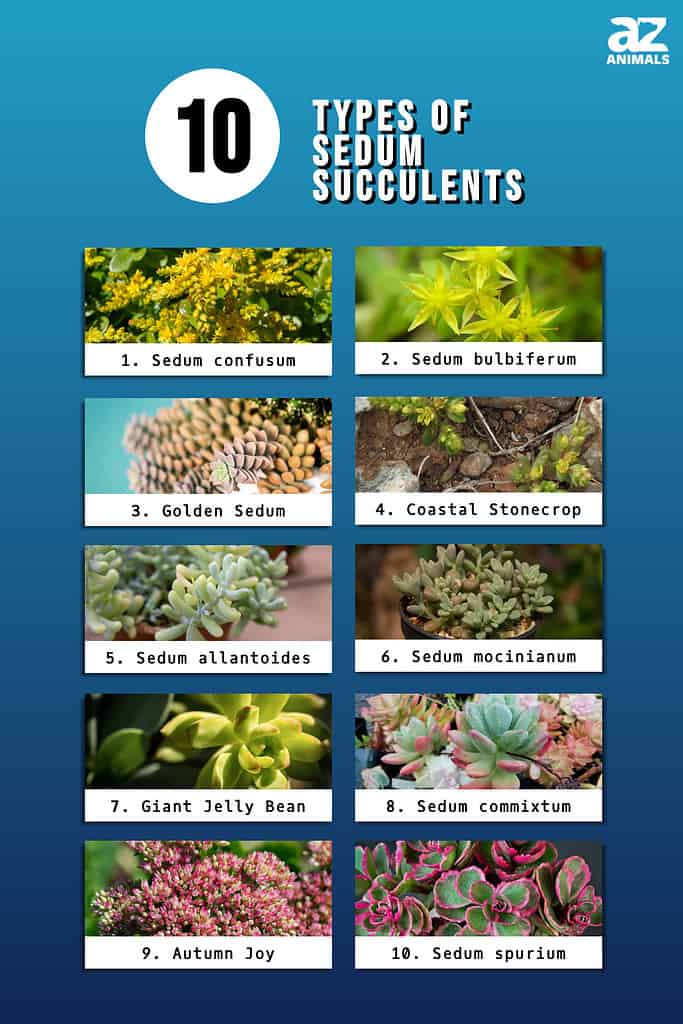
What Are Sedum Succulents?
Sedums are a genus of flowering plants in the Crassulaceae family. There are between 400 and 500 species that thrive in sun and well-drained conditions.
The name succulent is an umbrella term for plants that have fleshy water-storing parts enabling them to cope with drought. Different varieties store water in their roots, stems, or leaves for use when there is very little or no rainfall.
Some succulents have developed extra water storage abilities such as wrinkled, jagged skin that expands like a balloon to grab rainfall when it eventually comes, and teeth or spines that provide the water storage parts with shade. Most have shallow roots to suck up rainfall before it evaporates
The sedum genus was first described by Carl Linnaeus in 1753 and named after the Latin “sedum” for “houseleek.”
Sedum Succulent Types
There are 400-500 sedum succulents, so it would be impossible to list them all! Here are some of the most popular sedums currently grown as house or yard plants.
1. Sedum confusum
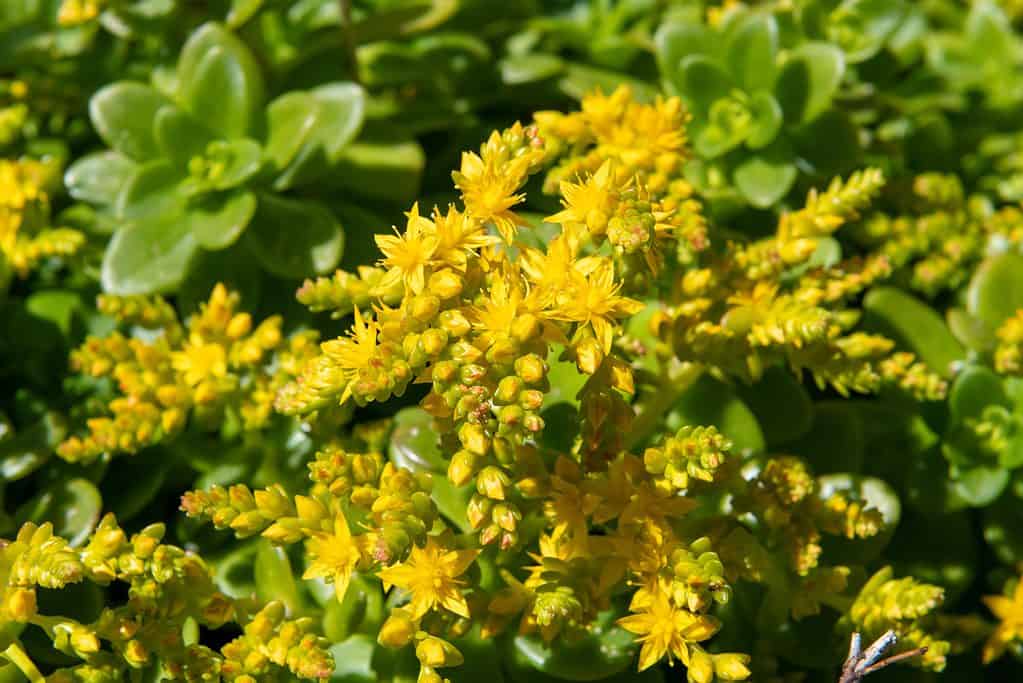
The
Sedum confusumis native to Mexico.
©Tom Meaker/Shutterstock.com
With glossy, dark green, fleshy leaves, this Mexican native sedum is a fantastic ground-covering succulent with each branch reaching 10 inches long. Its plump green leaves often develop a pinky tinge in full sun and its yellow star-shaped flowers sit pretty on top.
This is especially easy to grow in well-drained soil and needs barely any attention at all.
2. Sedum bulbiferum
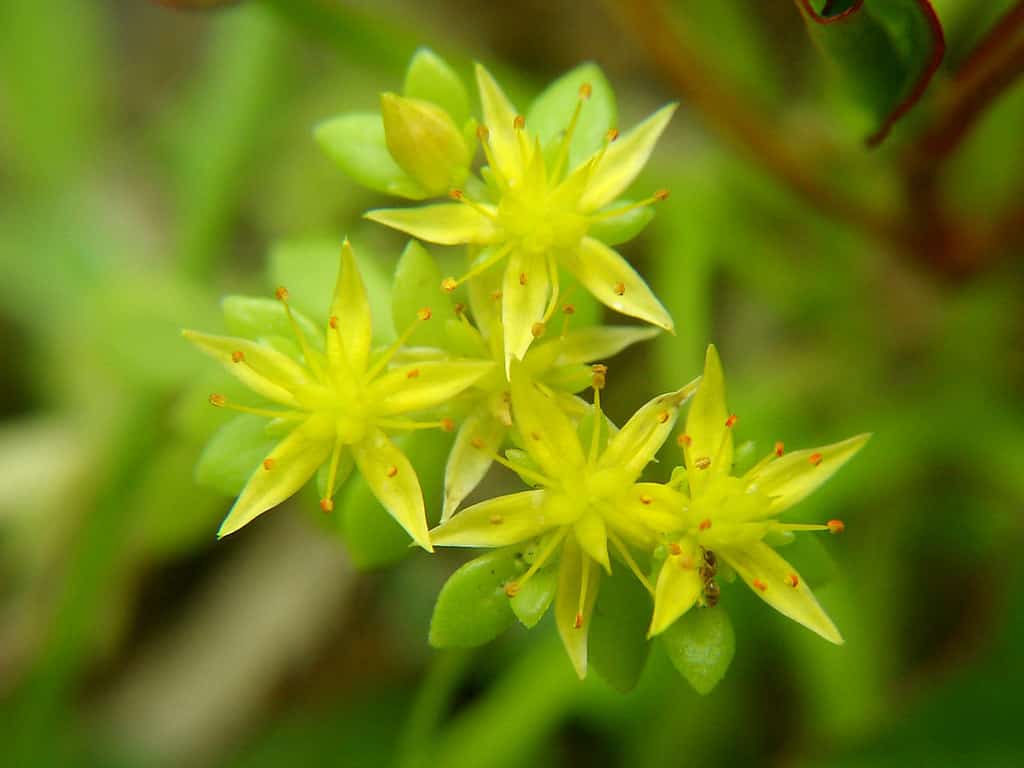
The
Sedum bulbiferumplant grows star-shaped yellow flowers at the tips of its thin stems.
©Ishikawa Ken / Flickr – License
This type of sedum succulent has many thin erect stems that reach two feet long and sweep upwards toward the sky. At the tips, star-shaped yellow flowers bloom.
It’s an Asian native and a bit different from other sedums because its straggly habit looks untamed and a little bit wild. It’ll take more cold than Mexican native sedums. This is a definite choice for dry yards.
3. Golden Sedum (Sedum adolphii)

While only being 12 inches tall,
Sedum adolphiican spread up to twice that across.
©Altin Osmanaj/Shutterstock.com
This little Mexican native succulent hugs the ground and spreads up to 24 inches across, despite only reaching 12 inches in height. It has thick evergreen leaves with a hint of golden yellow, hence its name. However, in direct sun it turns a little red at the tips.
Maximum sunshine will encourage a blaze of star-shaped yellow flowers.
4. Coastal Stonecrop (Sedum litoreum)
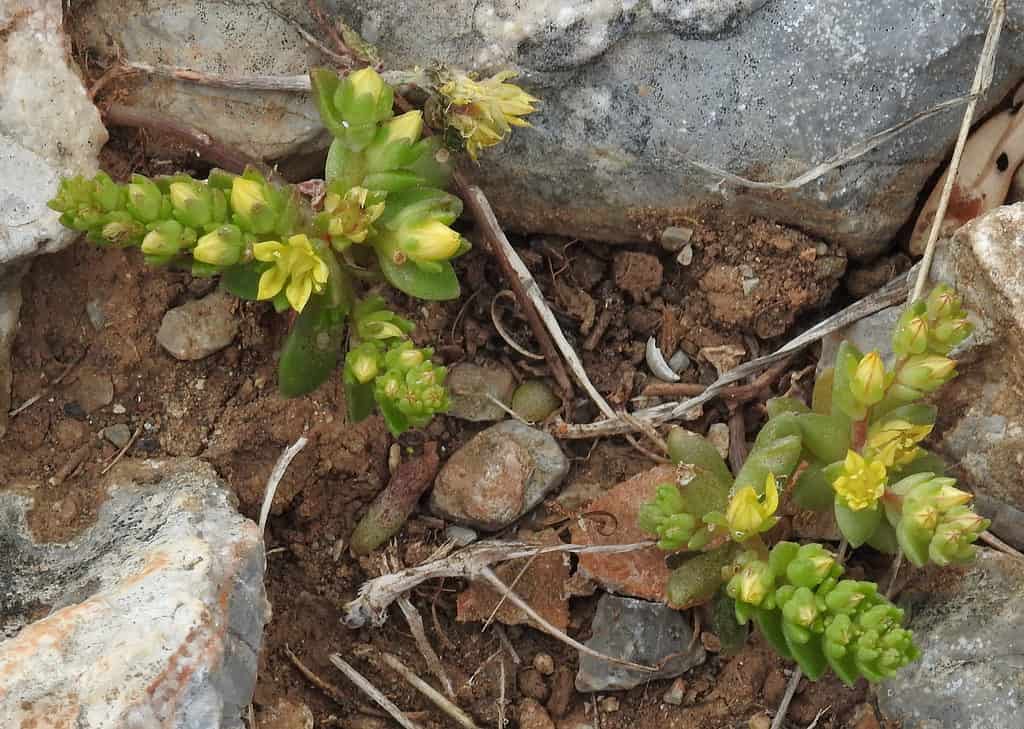
The coastal stonecrop has thick, green leaves and grows five inches high.
©Robert Flogaus-Faust / CC BY 4.0, via Wikimedia Commons – License
This is a small type of sedum succulent that’s an annual and native to the central and eastern Mediterranean coastal areas. It’s a small sedum with thick ovate green leaves that only reach five inches tall. Like many other sedums, it bears small yellow star-shaped flowers.
Its common name Stonecrop comes from an old saying that stones needed more attention!
5. Sedum allantoides
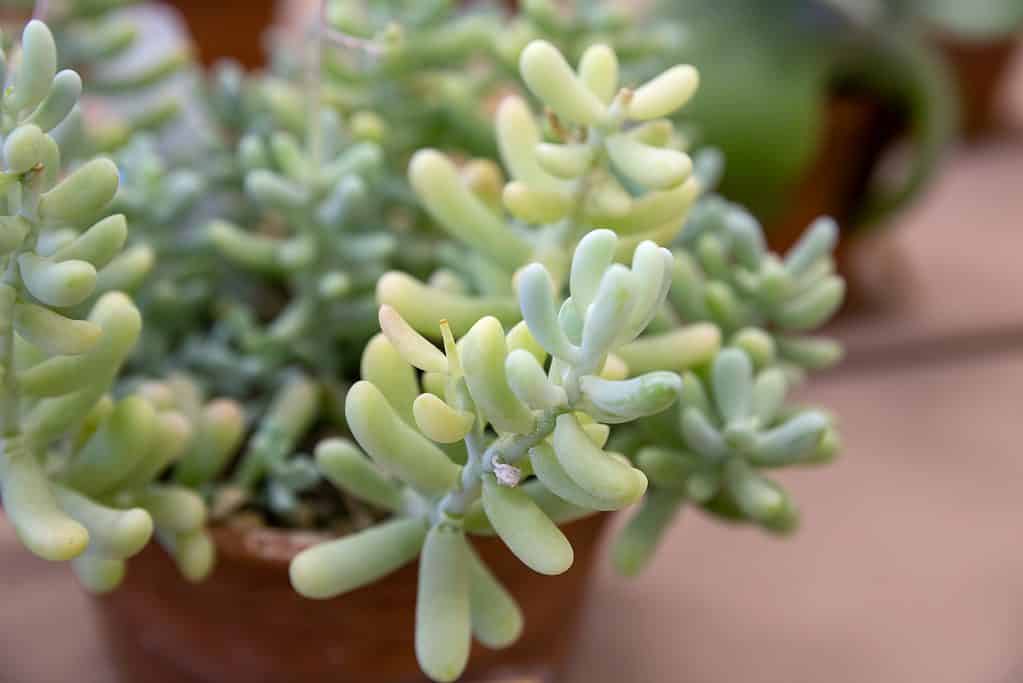
has bulbous, blue-green leaves.
©Yulia_B/Shutterstock.com
Sedum allantoides is an upright succulent sedum with bulbous, cylindrical blue-green leaves. Individual branches reach 12 inches and because it has a habit of building new, taller branches, it resembles a mini shrub and contrasts well with low-growing or trailing sedums.
Green-white flowers complement its powdery foliage if it gets enough sunshine.
6. Sedum mocinianum
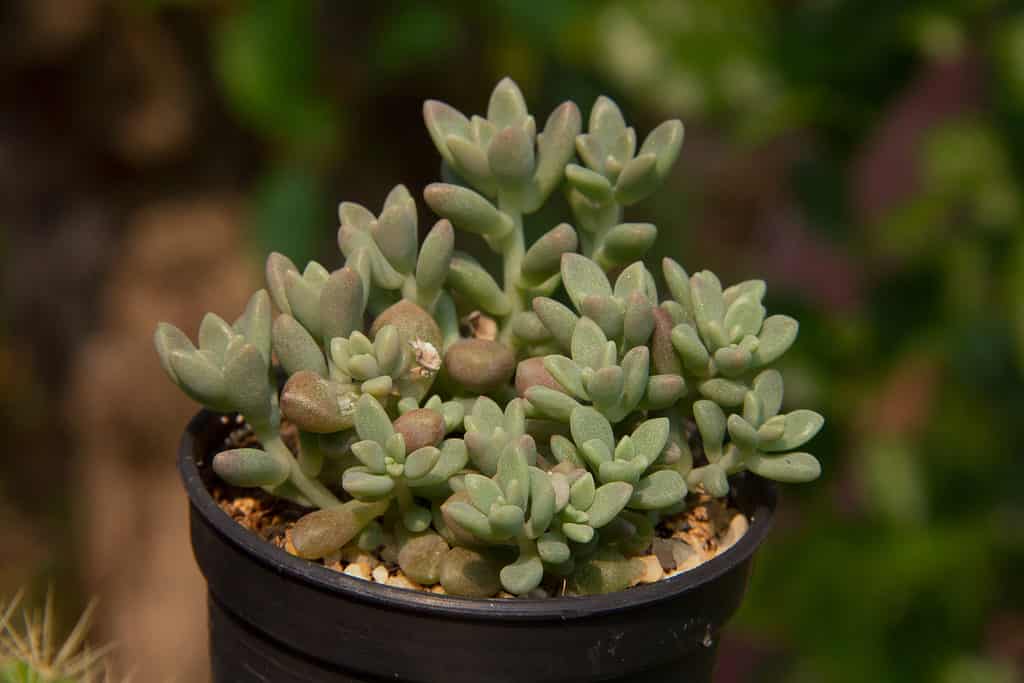
is named in honor of Jose Mocino, a Mexican botanist.
©noypb/Shutterstock.com
This sedum succulent is a hanging type with stems that reach 35 inches long. Each fleshy leaf grow to an inch and is covered in fine white hairs. Its delicate flowers are white and star-shaped with red anthers. It’s considered one of the most attractive sedums and it’s widely grown in pots or on top of a wall to show off its hanging branches.
Sedum mochinianum was named after the Mexican botanist Jose Mocino (1757-1820).
7. Giant Jelly Bean (Sedum lucidum)

Sedum lucidum is also called the giant
jelly bean
due to its rounded, green leaves with tips of red.
©Alberto Masnovo/Shutterstock.com
A real favorite with kids, the giant jelly bean sedum is named for its rounded, green jelly bean-like leaves with a red tint. It’s native to Mexico, reaches around seven inches in height, and blooms daisy-like flowers.
8. Sedum commixtum
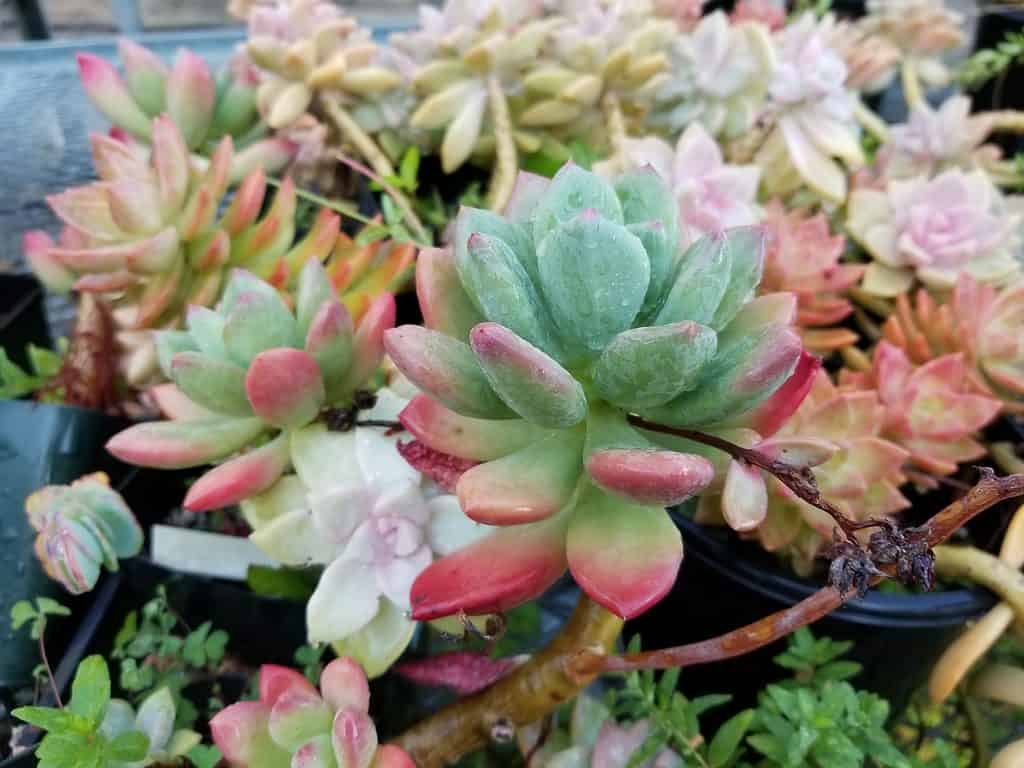
plants start out as gray-blue, then mature to purple-red.
©Nyan Xing/Shutterstock.com
This sedum is multi-colored with unique fleshy leaves that start life gray-blue and mature to purple-red. Because new leaves appear throughout its growing season, this sedum is a rainbow of muted hues for months on end.
Each stem rises 12 inches tall, much like a mushroom, so as well as color it produces shape and texture, too. This is a really fun sedum that even dangles upside down off cliffs in its native Mexico!
Are There Any Winter Hardy Types of Sedums?
Succulent sedums are usually warmth lovers, especially those native to Mexico and the Mediterranean, but there are perennial and evergreen sedums that can cope with the cold, down to minus temperatures.
9. Autumn Joy (Sedum spectabile)
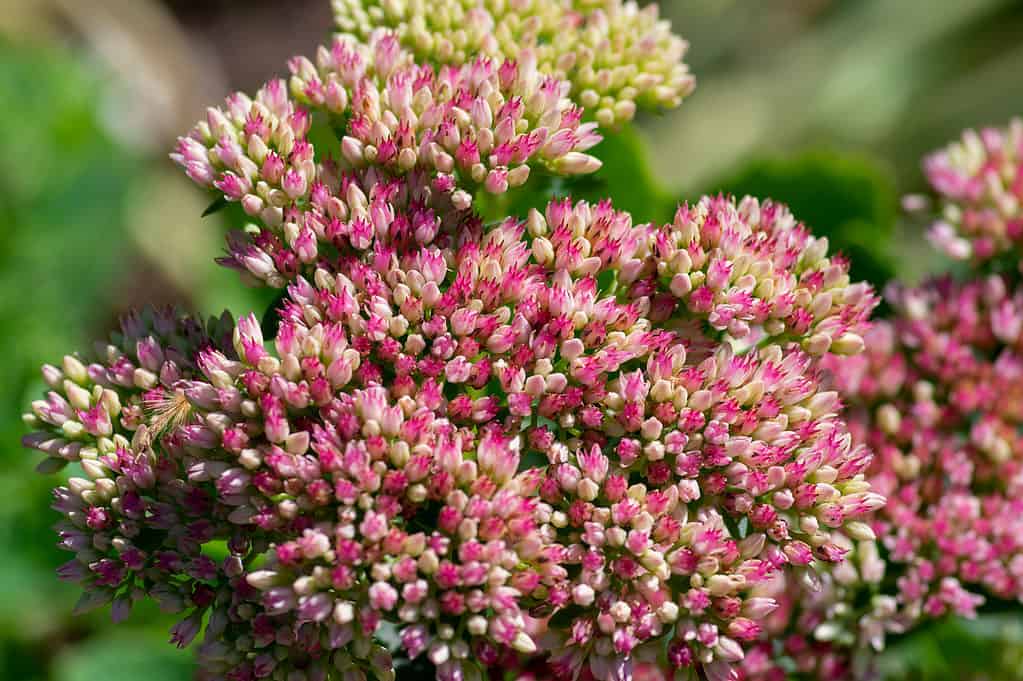
The
Sedum spectabileis popular due to its hardiness.
©Iva Vagnerova/Shutterstock.com
This fleshy-leaved tall sedum is a popular choice because it’s winter hardy.
It’s native to North America, where it’s more commonly known as an ice plant due to its icy-looking stems. In fall, as well as notched succulent leaves, this sedum produces large flat heads of pink flowers that are loved by pollinators. It’s an excellent choice for wildlife-friendly gardens.
It dies back to a root ball in the cold months, only to emerge again in late spring.
10. Sedum spurium

The Caucasian stonecrop is another name for the evergreen
Sedum spurium.
©Gerry Bishop/Shutterstock.com
The Caucasian stonecrop, or two-row stonecrop, is a mat-forming, low-growing winter hardy sedum. It has fleshy leaves that dangle neatly over container lips and roots if they make contact with soil. Sedum spurium produces star-shaped pink flowers in late summer that support pollinators.
This succulent sedum is a great choice to soften container edges, hang over a wall, or form a thick soil-protecting ground cover.
Sedum spurium is evergreen, so it colors your garden during the winter months and continues to grow when warm weather returns.
How to Look After Sedum Succulents
Sedum succulents are very easy to grow.
They like full sun, but will tolerate partial shade. If the position is too shady, they will stretch towards the sun and grow in a leggy, unattractive display and develop easily broken stems. Indoor and outdoor sedums will struggle to flower unless they receive around six hours of sunlight each day.
Another important factor when you’re growing sedums is the soil. Unlike many other plants, sedum enjoy dry, impoverished soil. In well-fertilized soil sedums put on a large growth spurt, but this creates top-heavy stems that sag and fall.
Because they enjoy sun and well-drained conditions, succulent sedums are excellent choices for a raised bed, container, or window box.
Check on species before planting sedum in zone 5 and below. As we’ve seen there are some winter hardy sedums, but many can’t cope with frost or lots of wet weather.
Will Sedum Succulents Grow in Shade?
They will, but their growth is likely to be poor, leggy, and sparse. They’ll also struggle to flower in shade and develop fungal rot from lingering dampness.
Does Sedum Grow Well in Pots?
Yes, types of succulent sedum grow well in pots because they enjoy well-drained conditions. Consistently wet soil is more likely to kill a sedum succulent than too much sun.
A container planted up with sedums is really unusual. Chose an upright sedum for the center, low growers for the mid sections, and hanging sedums around the margins, then place it in the sun. Pollinators will flock to the flowers!
What Happens to Sedum Succulents in Winter?
Tender sedums die over winter, but winter hardy sedums will lose their leaves and die back to the root ball. This type of behavior is called perennial.
Many plants are perennial so they can survive sub-zero temperatures, rain, and wind. In general, If your succulent sedum is a perennial type, it can survive winter in well-drained soil.
Are Sedum Succulents Toxic?
Sedums are not toxic to humans or pets. In fact, some, such as Sedum spectabile, make nutritious tortoise food.
However, some succulents — including snake plants, euphorbia succulents, and kalanchoe succulents — are poisonous if chewed up and they irritate uncovered skin.
Summary of 10 Types of Sedum Succulents
Here’s a recap of the 10 top sedum succulents that we took a look at.
| Number | Succulent | Size |
|---|---|---|
| 1 | Sedum confusum | Branches grow to around 10 inches long |
| 2 | Sedum bulbiferum | Stems can reach 2 feet long |
| 3 | Golden Sedum (Sedum adolphii) | Spreads up to 24 inches across and grows about 12 inches high |
| 4 | Coastal Stonecrop (Sedum litoreum) | Leaves grow to 5 inches tall |
| 5 | Sedum allantoides | Branches grow to 12 inches |
| 6 | Sedum mocinianum | Stems reach 35 inches long |
| 7 | Giant Jelly Bean (Sedum lucidum) | Grows around 7 inches high |
| 8 | Sedum commixtum | Stems grow to 12 inches tall |
| 9 | Autumn Joy (Sedum spectabile) | Dies back to a root ball in the cold months |
| 10 | Sedum spurium | Mat-forming, low-growing |
Types of Sedum Succulents: Which Are Best?
There’s a sedum succulent for everyone, whether you’re an indoor grower with a sunny windowsill or the owner of a drought-prone yard.
Sedums are such great plants because they come in an array of shapes and sizes, plus they are non-toxic and safe around children and pets. From upright fleshy leaves, to mushroom-type stalks, and dangling 3D ovals, sedums are possibly the most interesting plants around.
The photo featured at the top of this post is © Nyan Xing/Shutterstock.com
Sources
- Beth Chatto's Plants and Gardens, Available here: https://www.bethchatto.co.uk/a-z/s-z/sedum/
- GardenersWorld, Available here: https://www.gardenersworld.com/how-to/grow-plants/how-to-grow-sedums/
- VanWoert, Nicholaus D., et al., Available here: https://journals.ashs.org/hortsci/view/journals/hortsci/40/3/article-p659.xml
Thank you for reading! Have some feedback for us? Contact the AZ Animals editorial team.






